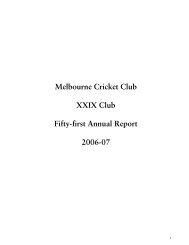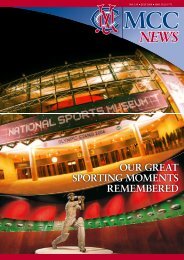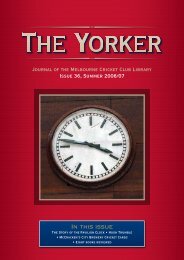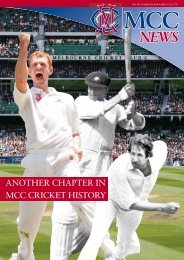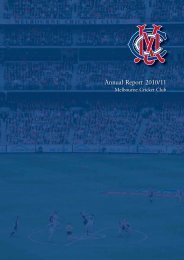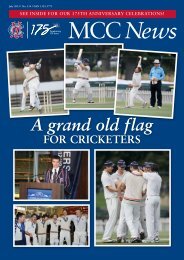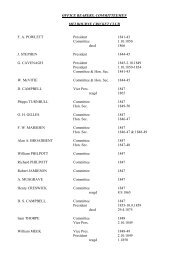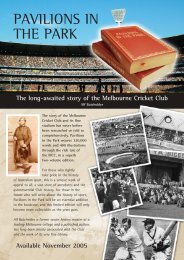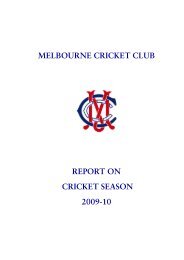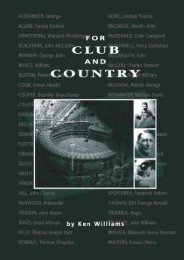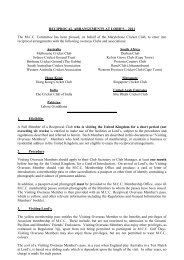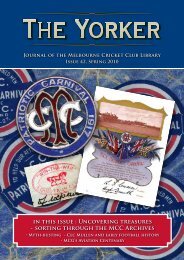Celebrating 175 years - Melbourne Cricket Club
Celebrating 175 years - Melbourne Cricket Club
Celebrating 175 years - Melbourne Cricket Club
You also want an ePaper? Increase the reach of your titles
YUMPU automatically turns print PDFs into web optimized ePapers that Google loves.
CLUB NEWS<br />
Join us in a birthday<br />
celebration<br />
LEFT: Early days… Our first Pavilion<br />
(1853) provides a restful backdrop to this<br />
photograph of Tom Wills with members of<br />
an aboriginal team that played the MCC in<br />
December 1866. Note the curator’s cottage<br />
at rear and the middle gable of the Pavilion,<br />
which contains a clock (obscured) that still<br />
beats truly 150 <strong>years</strong> after its installation<br />
in 1863. You’ll find it mounted above the<br />
escalators leading to the Percy Beames Bar<br />
on Level 2. History lives.<br />
To many cricket fans, it’s a bumper<br />
Ashes year. For the MCC, however,<br />
2013 represents the <strong>175</strong>th<br />
anniversary of the club’s formation, and<br />
that’s cause for celebration.<br />
From April 1 until the end of this year<br />
there will be a number of opportunities for<br />
members, waiting list candidates and the<br />
public to join us in marking a milestone for<br />
one of Victoria’s oldest institutions that has<br />
been an integral part of <strong>Melbourne</strong> life since<br />
establishment in 1838.<br />
Much of the focus will centre on the<br />
weekend of November 15-17, coinciding<br />
with the birth of the club, when we plan to<br />
hold several events at the MCG.<br />
The MCC was founded on November 15,<br />
1838 when five men - Frederick Powlett,<br />
Robert Russell, George B. Smyth and<br />
brothers Alfred and Charles Mundy - agreed<br />
to form a cricket club to be known as the<br />
<strong>Melbourne</strong> <strong>Cricket</strong> <strong>Club</strong>.<br />
Two days later, after purchasing the<br />
necessary cricket equipment, the members<br />
of the <strong>Melbourne</strong> <strong>Cricket</strong> <strong>Club</strong> played their<br />
first match, among themselves, near the<br />
former Royal Mint site in William Street.<br />
The MCC was prominent in developing the<br />
colony’s cricket and played a major role in<br />
guiding the game until after the turn of the<br />
20th century. For example, the club sponsored<br />
four Australian teams to England and eight<br />
visits to Australia between 1879 and 1905.<br />
Alf Batchelder’s estimable book on the<br />
history of the club, Pavilions in the Park,<br />
outlines the club’s early days:<br />
“The first members were pastoralists,<br />
government officials, bankers, insurance men<br />
and merchants. In the main, their presence in<br />
the colony was a direct result of the<br />
opportunities generated by the wool industry.<br />
For men in their late twenties or their<br />
thirties, the club offered a means of<br />
recreation and of socialising with one<br />
another. The concept of playing matches<br />
against any other group was very low on<br />
their priorities.<br />
Initially, it was not intended to establish a<br />
club in perpetuity – until well into 1840s, the<br />
MCC and other sporting clubs in <strong>Melbourne</strong><br />
As readers will have noted on<br />
the front cover, the club has<br />
struck a new logo for use<br />
during our <strong>175</strong>th anniversary<br />
year.<br />
Used in conjunction with the<br />
existing MCC logo, rather than<br />
replacing it, the new look is<br />
based on the idea of a sparkler<br />
and the sensory experience of<br />
celebration.<br />
The fluid and dynamic motion<br />
symbolises the continual<br />
progression of the MCC as an<br />
organisation, always moving<br />
forward and improving the club<br />
and ground.<br />
re-formed annually as the season for their<br />
activities approached.”<br />
And so <strong>175</strong> <strong>years</strong> of club sport, evolving<br />
into today’s model of stadium manager,<br />
heritage preserver, tourism operator and<br />
custodian of public parkland, was under way.<br />
For more information about the MCC’s<br />
<strong>175</strong>th anniversary, keep an eye on our<br />
website and social media channels in the<br />
coming weeks. MCC members and their<br />
families are encouraged to participate in the<br />
festivities and join us in celebrating this<br />
remarkable milestone.<br />
MCC ID VALUED HIGHLY<br />
We doubt that our electronic<br />
membership cards will be<br />
keenly sought in 100 <strong>years</strong>’ time,<br />
but the old MCC badges, first<br />
introduced in 1901, have certainly<br />
become a valuable item going by<br />
the results of a recent Charles<br />
Leski auction.<br />
The first badge, which featured<br />
the coat of arms of the city of<br />
<strong>Melbourne</strong> and was undated, sold<br />
for 10 times the auctioneer’s<br />
estimate and an incomplete set<br />
brought more than $14,000, a sure<br />
indication that our badges have<br />
become a favourite among<br />
collectors.<br />
A complete set of Full members’<br />
badges is on display in the MCC<br />
Museum.<br />
An interesting feature of the<br />
badges is that the designer’s<br />
version of the MCC logo, first seen<br />
on the 1902-03 edition, changes<br />
almost annually, something that<br />
would be heresy under today’s style<br />
guide constraints.<br />
Before the badges were<br />
introduced, a member’s folding<br />
card (left), signed by the office<br />
bearers of the day, was in vogue.<br />
If you happen to come across one,<br />
please let us know.<br />
March 2013<br />
MCC NEWS<br />
5



